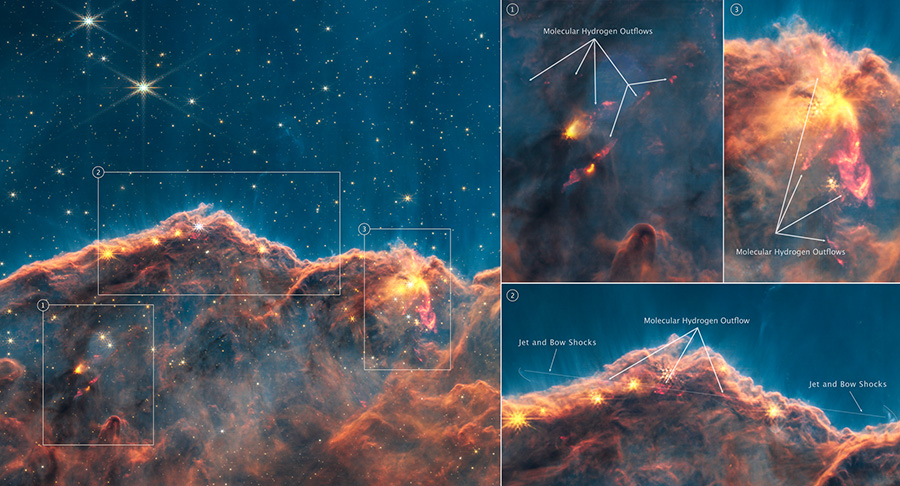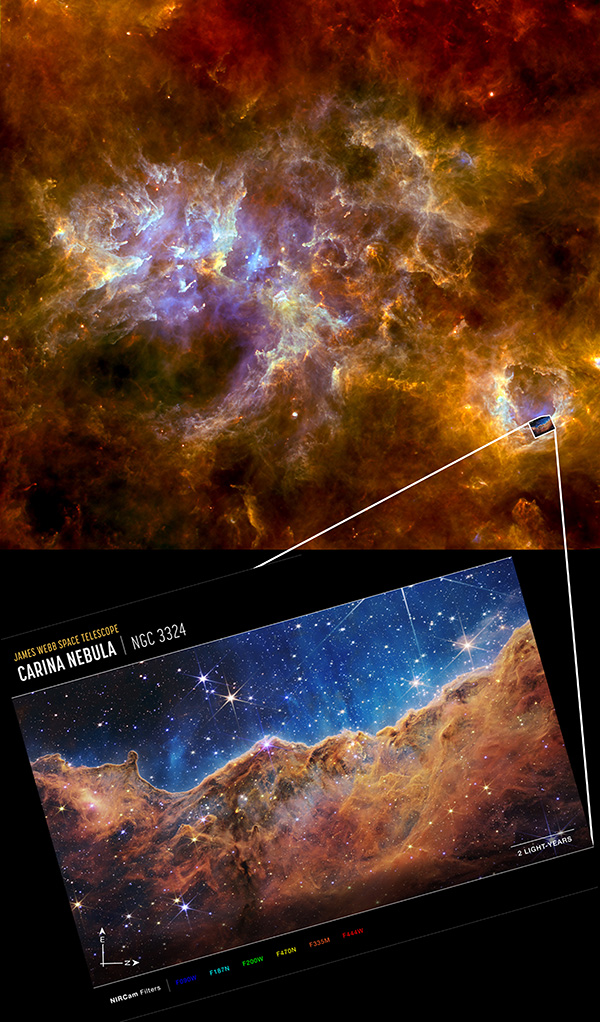The James Webb Space Telescope’s early-release image of the Cosmic Cliffs is revealing growth spurts in young stars.

IMAGE: NASA / ESA / CSA / STScI; Science: Megan Reiter (Rice University); Image processing: Joseph DePasquale (STScI), Anton M. Koekemoer (STScI)
One of the first images to be released by the James Webb Space Telescope team showed protostars growing in the nebulous edges of a giant star-blown bubble, NGC 3324. This bubble wall, dubbed the Cosmic Cliffs, surrounds massive O stars, which lie outside the image frame.
Now, a team of astronomers is taking a closer look at this bubble wall, revealing never-before-seen details of star formation in this region.
When the Hubble Space Telescope examined the same space, astronomers detected only a few stellar outflows. The dusty wall that surrounds the bubble stymies visible-light observations, but Webb's near-infrared capabilities enable it to penetrate the dust, revealing the outflows of protostars still embedded in the bubble wall.
These stars are so young, they haven't yet begun fusing hydrogen in their cores. They're growing quickly, amassing gas and dust in accretion disks that are far too small too see. But as part of that growth, they're also blowing away gas and dust in thin jets that can extend light-years long, leaving a sort of "fossil record" of how feeding and growth has changed over time.
In the Webb data, Megan Reiter (Rice University) and colleagues found 24 new outflows by the glow of molecular hydrogen at near-infrared wavelengths. The team also identified the protostars that could be driving these outflows, although these identifications will still need to be confirmed. Reiter presented these results at last week's First Science Results from JWST conference.
The stars that create these outflows are still buried in dust, and neither they nor their outflows have been exposed to the harsh radiation coming from the massive O stars at the center of NGC 3324. The discoveries therefore offer a glimpse of the first, jet-driven stages of stellar feedback, before harsh radiation, stellar winds, and supernovae take over.
As Webb continues to observe these outflows over the years, astronomers will be able to estimate how fast these outflows are moving and how much mass they're carrying. Then we'll be able to learn, among other things, how these flows impact planet formation in these stellar systems' earliest years.
Meanwhile, this preliminary analysis shows what the space telescope can do: “These Early Release Observations represent the tip of the iceberg of what is possible for star-formation studies with JWST,” the team concludes.
Read more in the JWST press release and in the study that appears in the Monthly Notices of the Royal Astronomical Society.

Cosmic Cliffs: NASA / ESA / CSA / STSCI; Wider-field context: ESA / PACS / SPIRE / Thomas Preibisch / Universitäts-Sternwarte München and Ludwig-Maximilians-Universität München, Germany / Matt Povich (California Polytechnic State University)
 0
0









Comments
You must be logged in to post a comment.